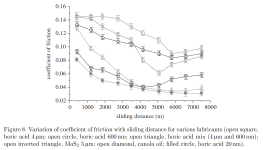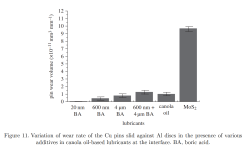scianiac
10 kW
- Joined
- Oct 24, 2018
- Messages
- 654
I did find some research comparing MoS2 to BA directly and the results are pretty decent. Here are the two most relevant graphs:


So basically friction wise it's better only if the particle size is small enough, although I think it's kind of unfair to compare MoS2 only at 5um. It easily beats the 4um BA so how would smaller MoS2 perform, possibly far better. The wear on the other hand is more interesting and the paper does go into caveats about how the particle size starts doing weird stuff at some point and that could be the reason the MoS2 did so much worse than just the oil. Basically if particles are too large they can add to abrasive wear and if too small they can cause adhesive wear depending on the materials and surface. Also these tests were done with copper on aluminum which seems kind of weird to me. Regardless the fact that the 4um BA did so much better than the 5um MoS2 I think says something.
I think the takeaway is smaller is better for BA although not sure about sourcing 20nm BA. And this is still not some magic additive, it's good at some things, better in some ways, worse in others (like it's comparatively terrible temperature stability).
Although thinking about it there are a lot of other variables here, the reason cited in the paper for smaller is better is just because they can fit between the metals better, get sucked in and caught on micro surface features. Which makes me wonder how the lubricant effects things, for instance and grease vs an oil. Also with chain wax the idea is the wax is solid so it stays in place better, basically getting smeared in between the metals surfaces and harder to push out of the way than oil. But is still gets pushed all the way though and the additives start to work so idk.
I still think adding BA to motor oil is probably a bad idea, probably for some of the same reasons they don't add MoS2 to modern motor oils, it doesn't stay suspended well, clogs filters, interferes with other additives, causes particle emissions that coat cats, etc.


So basically friction wise it's better only if the particle size is small enough, although I think it's kind of unfair to compare MoS2 only at 5um. It easily beats the 4um BA so how would smaller MoS2 perform, possibly far better. The wear on the other hand is more interesting and the paper does go into caveats about how the particle size starts doing weird stuff at some point and that could be the reason the MoS2 did so much worse than just the oil. Basically if particles are too large they can add to abrasive wear and if too small they can cause adhesive wear depending on the materials and surface. Also these tests were done with copper on aluminum which seems kind of weird to me. Regardless the fact that the 4um BA did so much better than the 5um MoS2 I think says something.
I think the takeaway is smaller is better for BA although not sure about sourcing 20nm BA. And this is still not some magic additive, it's good at some things, better in some ways, worse in others (like it's comparatively terrible temperature stability).
Although thinking about it there are a lot of other variables here, the reason cited in the paper for smaller is better is just because they can fit between the metals better, get sucked in and caught on micro surface features. Which makes me wonder how the lubricant effects things, for instance and grease vs an oil. Also with chain wax the idea is the wax is solid so it stays in place better, basically getting smeared in between the metals surfaces and harder to push out of the way than oil. But is still gets pushed all the way though and the additives start to work so idk.
I still think adding BA to motor oil is probably a bad idea, probably for some of the same reasons they don't add MoS2 to modern motor oils, it doesn't stay suspended well, clogs filters, interferes with other additives, causes particle emissions that coat cats, etc.




